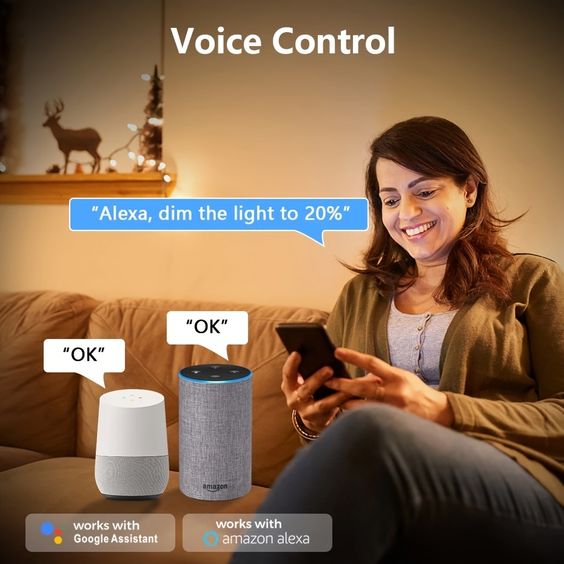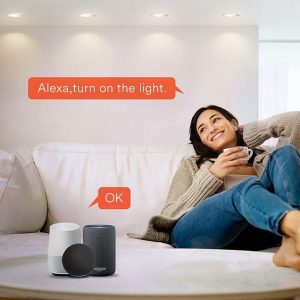Popular
How to Control Smart Light with Voice

How to Control Smart Light with Voice
Introduction: Embracing the Future of Lighting Control – Voice-Activated Smart Lights
In today’s fast-paced world, we’re always looking for ways to make our lives more convenient and efficient. From smartphones to smart homes, technology has made it possible to streamline many aspects of our daily routines. Smart lighting is a prime example of how technology can enhance our lives, offering not only efficiency but also a touch of modern elegance to our homes. In this article, we’ll embark on a journey to explore the world of smart lighting and how you can harness the power of voice control to illuminate your living spaces effortlessly.
Smart Lights: A Glimpse into the Future
Imagine a world where you can adjust the lighting in your home with a simple voice command. Want to create a cozy, dimly lit atmosphere for a movie night? Just say the word, and your lights will set the perfect mood. Need to turn on the lights before entering a room with your hands full of groceries? A voice command is all it takes. This is the promise of smart lights.
The Convenience of Voice Control
At the heart of this innovation lies voice control, a feature made possible by integrating smart lighting systems with popular voice assistant platforms like Amazon Alexa, Google Assistant, and Apple’s Siri. This synergy between technology and user-friendly voice commands has transformed the way we interact with our lighting.
But why should you consider controlling your lights with your voice? Here are some compelling reasons:
1. Hands-Free Operation: With voice control, you can operate your lights without lifting a finger. This is not only incredibly convenient but also a boon for individuals with limited mobility.
2. Effortless Customization: Adjusting the brightness, color, and ambiance of your lighting has never been easier. You can fine-tune your lighting to suit any occasion or mood.
3. Seamless Integration: Smart lights seamlessly integrate with other smart home devices, allowing you to create custom automation routines. For example, you can program your lights to dim when you start a movie or gradually brighten in the morning to simulate a natural sunrise.
4. Energy Efficiency: Smart lights can help you reduce energy consumption by allowing you to schedule lights to turn off when not needed or by adjusting brightness levels.
5. Wow Factor: There’s a certain wow factor associated with voice-controlled smart lights. Guests will be impressed by your ability to command your lighting with your voice, making your home feel more futuristic.
In the sections to follow, we will delve deeper into the world of smart lighting, guiding you through the setup process, voice assistant platforms, and the basic and advanced voice commands that will transform the way you interact with your lights.
So, if you’re ready to embrace the future of lighting control and make your home smarter, more efficient, and, of course, more stylish, keep reading. The world of voice-activated smart lights is just a few commands away.
Stay tuned for the next part of this series where we will guide you through the process of setting up your smart lights, choosing the right smart bulbs, and connecting them to your Wi-Fi network. Get ready to bring your home into the future with the magic of voice control and smart lighting.
Setting Up Your Smart Lights: The Gateway to Voice Control
In the previous section, we explored the exciting world of smart lighting and the myriad benefits of voice-activated control. Now, it’s time to roll up your sleeves and bring this futuristic technology into your home. The first step on this journey is setting up your smart lights, and we’ll guide you through the process, making it as smooth as possible.
Selecting Compatible Smart Light Bulbs
Before you can start talking to your lights, you need the right bulbs to listen. Here’s how to choose smart light bulbs:
1. Check Compatibility: Not all smart bulbs are compatible with every voice assistant platform. Ensure the bulbs you choose work with your preferred voice assistant, such as Amazon Alexa, Google Assistant, or Apple’s HomeKit.
2. Bulb Type: Decide whether you want smart bulbs that fit into your existing light fixtures or if you prefer smart bulbs with built-in fixtures. Common options include standard A19 bulbs, candelabra bulbs, and floodlights.
3. Color or White Ambiance: Some smart bulbs offer the ability to change colors, while others provide different shades of white light. Choose the type that suits your lighting needs.
4. Lumens and Brightness: Consider the brightness of the bulbs, typically measured in lumens. Think about the rooms where you’ll use these bulbs and select the appropriate brightness level.
5. Brand and Quality: Opt for well-established brands known for their reliability and quality.
6. Budget: Smart bulbs come in various price ranges. Set a budget that aligns with your requirements.
Installing Smart Light Bulbs
Once you have your smart bulbs in hand, it’s time to install them. Here’s a general installation process:
1. Turn Off Power: Always turn off the power to the existing light fixture before attempting any installation. Safety first.
2. Replace Existing Bulbs: Remove your old bulbs and replace them with the new smart bulbs. If your smart bulbs have separate components, follow the manufacturer’s instructions for assembly.
3. Power On: Turn the power back on, and the smart bulbs should light up.
Connecting Smart Lights to Your Wi-Fi Network
To enable voice control, your smart lights need to be connected to your Wi-Fi network. This typically involves the following steps:
1. Download the App: Most smart lighting systems have dedicated apps. Download the app for your specific brand of smart bulbs from the App Store or Google Play Store.
2. Create an Account: Follow the app’s instructions to create an account if required.
3. Add Your Smart Lights: The app will guide you through the process of adding your smart lights. This usually involves scanning a QR code or following on-screen prompts.
4. Connect to Wi-Fi: The app will prompt you to connect your smart lights to your Wi-Fi network. You’ll need to enter your Wi-Fi credentials for this step.
5. Name Your Lights: It’s a good practice to assign unique names to each of your smart lights. For example, you can name a light in the living room “Living Room Lamp.”
6. Firmware Updates: Check for firmware updates for your smart bulbs and install them if available. These updates can improve functionality and security.
With your smart lights successfully set up and connected to your Wi-Fi network, you’re now ready to pair them with your chosen voice assistant platform. In the next part of this series, we’ll explore the different voice assistant options and how to seamlessly integrate your smart lights for voice control. Get ready to turn your lights on and off with just the sound of your voice.
Voice Assistants and Smart Lights: A Perfect Pairing
In the previous sections, we covered the selection and installation of smart light bulbs, as well as connecting them to your Wi-Fi network. Now, it’s time to delve into the world of voice assistants and how they can transform your smart lights into responsive and efficient household fixtures.
Popular Voice Assistant Platforms
Before you can start controlling your lights with your voice, you’ll need to choose a voice assistant platform. Here are a few of the most popular options:
1. Amazon Alexa: Alexa, the voice assistant behind Amazon Echo devices, is renowned for its compatibility with a wide range of smart home devices, making it a top choice for many.
2. Google Assistant: Google Assistant, used in Google Home and Nest devices, is known for its natural language processing and extensive knowledge base.
3. Apple HomeKit: HomeKit is Apple’s ecosystem for smart home devices, and it’s tightly integrated with Siri, Apple’s voice assistant. It’s a great choice if you’re already invested in the Apple ecosystem.
4. Other Voice Assistants: There are other voice assistant platforms like Samsung Bixby, Microsoft Cortana, and more. Choose one that aligns with your preferences and existing devices.
Setting Up a Voice Assistant Device
To enable voice control of your smart lights, you’ll need a compatible voice assistant device, such as an Amazon Echo or a Google Home. Here’s how to set it up:
1. Purchase and Unbox: Acquire the voice assistant device of your choice and unbox it.
2. Power On and Connect: Plug in your device and follow the setup instructions to connect it to your Wi-Fi network.
3. Link Accounts: You’ll need to link your voice assistant device to the same accounts you used to set up your smart lights. This ensures seamless communication between the two.
4. Discover Devices: Use the voice assistant app to discover your smart lights. This usually involves scanning for new devices or linking them by brand.
5. Assign Names: Make sure the names you assigned to your smart lights during the initial setup match the names you’ll use when giving voice commands.
Controlling Your Smart Lights with Voice Commands – How to Control Smart Light with Voice
Once your voice assistant device is set up and your smart lights are linked, it’s time to start using voice commands to control your lights. Here are some basic voice commands to get you started:
1. “Hey [Voice Assistant], turn on the [Light Name].“: This command will turn on the specified smart light.
2. “Hey [Voice Assistant], turn off the [Light Name].“: This command will turn off the specified smart light.
3. “Hey [Voice Assistant], set the [Light Name] to 50%.“: Adjust the brightness of the light to the desired level.
4. “Hey [Voice Assistant], change the [Light Name] to blue.“: If your smart lights support color changes, use this command to alter the light’s color.
5. “Hey [Voice Assistant], create a [Scene Name] in the [Room] with [Light Names].“: Create customized lighting scenes to set the mood for various occasions.
6. “Hey [Voice Assistant], set a schedule to turn on the [Light Name] at [Time].“: Schedule your lights to turn on or off at specific times.
Benefits of Voice Control for Smart Lights
The integration of voice assistants with smart lights offers numerous advantages, including:
- Hands-Free Convenience: You can control your lights while cooking, working, or simply relaxing without needing to reach for a switch or your phone.
- Customization: Adjust lighting according to your preferences, making it bright for tasks or dim for ambiance.
- Seamless Integration: Voice assistants can control multiple smart devices, allowing you to create complex automation routines.
- Accessibility: Voice control is a game-changer for individuals with disabilities or limited mobility.
In the upcoming sections, we’ll explore advanced voice commands, grouping lights for simultaneous control, and troubleshooting common issues. Get ready to elevate your home’s lighting experience with voice-controlled smart lights.
Advanced Voice Control for Smart Lights: Creating Magic with Your Words
In the previous sections, we covered the basics of setting up your smart lights and integrating them with voice assistant platforms. Now, it’s time to unlock the full potential of your voice-controlled smart lights by exploring advanced voice commands and features that can truly transform your living spaces.
Creating Lighting Scenes
One of the most exciting aspects of voice-controlled smart lights is the ability to create customized lighting scenes for different occasions. Here’s how to do it:
1. “Hey [Voice Assistant], create a [Scene Name] in the [Room] with [Light Names].“: Use this command to set up a new lighting scene. For example, “Hey Google, create a Relax scene in the Living Room with the Lamp and the Ceiling Light.”
2. “Hey [Voice Assistant], activate the [Scene Name].“: Once you’ve created a scene, you can activate it with a simple voice command. For instance, “Hey Alexa, activate Movie Night in the Home Theater.”
3. “Hey [Voice Assistant], adjust the [Scene Name] to [Brightness/Color].“: Fine-tune your scenes by specifying the desired brightness or color. For example, “Hey Siri, adjust the Party scene to 75% brightness.”
Scheduling Lighting Changes
Smart lights make it easy to schedule lighting changes, helping you automate your home’s lighting according to your daily routine. Here’s how to do it:
1. “Hey [Voice Assistant], set a schedule to turn on the [Light Name] at [Time].“: Use this command to schedule your lights to turn on or off at specific times. For instance, “Hey Google, set a schedule to turn on the Porch Light at 7:00 PM.”
2. “Hey [Voice Assistant], turn on [Scene Name] at [Time].“: You can also schedule lighting scenes to activate automatically at certain times. For example, “Hey Siri, turn on the Evening Relax scene at 8:30 PM.”
3. “Hey [Voice Assistant], cancel the [Schedule/Scene Name].“: If you need to make changes or cancel a scheduled event, simply use this command.
Grouping Lights for Simultaneous Control
If you have multiple smart lights in a room, you can group them for synchronized control. Here’s how:
1. “Hey [Voice Assistant], create a group named [Group Name] with [Light Names].“**: Create a group that includes specific smart lights. For example, “Hey Alexa, create a group named Kitchen Lights with the Island Light and the Under-Cabinet Light.”
2. “Hey [Voice Assistant], turn on/off the [Group Name].“: Control all the lights in a group simultaneously with a single command.
3. “Hey [Voice Assistant], set [Group Name] to [Brightness/Color].“: Adjust the brightness or color of all the lights in a group at once.
Benefits of Advanced Voice Control
These advanced voice control features take your smart lighting experience to the next level. Here are the benefits:
- Effortless Ambiance: Create the perfect atmosphere for any situation with just a few words.
- Automated Lighting: Set up lighting schedules to match your daily routines, enhancing energy efficiency.
- Centralized Control: Grouping lights simplify control in larger rooms or throughout your home.
- Enhanced Comfort: Fine-tune your lighting to cater to your specific needs, whether it’s work, relaxation, or entertainment.
In the next sections, we’ll explore common troubleshooting tips for voice-controlled smart lights, ensuring that your experience remains smooth and hassle-free. Additionally, we’ll discuss important voice command etiquette and considerations for privacy and security. So, continue on your journey to master the art of controlling your lights with your voice, and elevate your home’s ambiance to new heights.
Troubleshooting and Best Practices: Ensuring Seamless Voice Control for Your Smart Lights
In the previous sections, we explored the world of voice-controlled smart lights, from basic voice commands to advanced features that can transform your home’s lighting. However, like any technology, smart lights and voice assistants can encounter issues. In this section, we’ll discuss common troubleshooting tips, voice command etiquette, and important considerations for privacy and security.
Troubleshooting Common Issues
Even the most advanced technology can sometimes encounter hiccups. Here’s how to troubleshoot common problems:
1. Wi-Fi Connectivity Issues: If your smart lights are unresponsive, check your Wi-Fi connection and make sure your smart lights are connected to the same network.
2. Device Pairing Problems: If your voice assistant can’t discover your smart lights, ensure they are correctly added to your smart lighting app and that the voice assistant platform supports them.
3. Firmware Updates: Periodically check for firmware updates for your smart lights and voice assistant devices. Outdated software can lead to compatibility issues.
4. Voice Recognition Problems: If your voice assistant isn’t recognizing your voice commands correctly, consider retraining or reconfiguring the voice recognition settings.
5. Power Outages: Smart lights may revert to their default state after a power outage. In such cases, you may need to manually reset your preferences.
6. Interference: Electronic interference or a crowded Wi-Fi network can disrupt the smart light operation. Ensure your Wi-Fi router is located centrally in your home for better coverage.
Voice Command Etiquette
While controlling your lights with your voice is convenient, it’s essential to use voice commands with courtesy and consideration, especially in shared spaces. Here are some etiquette tips:
1. Speak Clearly: Enunciate your commands clearly to ensure your voice assistant understands you correctly.
2. Volume Control: Avoid shouting at your voice assistant. Speaking in a normal tone is usually sufficient.
3. Consider Others: If you’re in a shared space, be mindful of others, and don’t activate your voice assistant unnecessarily.
4. Mute or Disable: Most voice assistants have a mute or disable feature. Use it when you don’t want your voice assistant to respond.
Privacy and Security Considerations
Voice-activated smart lights can be a powerful tool, but they can also raise privacy and security concerns. Here’s how to safeguard your privacy:
1. Review Permissions: Regularly review the permissions you’ve granted to your voice assistant platform and smart lighting app. Make sure you’re comfortable with the data they collect.
2. Secure Your Network: Ensure your Wi-Fi network is secured with a strong password and up-to-date security protocols.
3. Disable Features: If you have privacy concerns, consider disabling features like voice recognition or limiting the data your voice assistant collects.
4. Regularly Update: Keep both your smart lights and voice assistant devices up to date with the latest firmware and software updates to patch security vulnerabilities.
With these troubleshooting tips, etiquette considerations, and security measures in mind, you can enjoy the full benefits of voice-controlled smart lights while maintaining your privacy and ensuring a smooth and pleasant experience.
In conclusion, voice-controlled smart lights offer a remarkable blend of convenience, customization, and ambiance for your home. By mastering the art of voice control and following best practices, you can create a futuristic and responsive lighting environment that caters to your every need. Now, go forth and illuminate your world with the power of your voice.
I’m glad you’re finding this information helpful. In the next section, we’ll wrap up this article with a conclusion, summarizing the key points and encouraging the end users to embrace the convenience and elegance of voice-controlled smart lights.
Conclusion: Illuminating the Future with Voice-Activated Smart Lights
As we conclude this journey through the world of voice-controlled smart lights, it’s clear that the fusion of technology and convenience has the power to transform our living spaces. By integrating smart lighting systems with voice assistant platforms, we’ve unlocked a new realm of possibilities for our homes. In this concluding section, let’s recap the key points and encourage you to embrace this modern lighting experience.
Recap of Key Points
1. Smart Lighting: Smart lights offer the ability to control your lighting with precision, from brightness adjustments to color changes.
2. Voice Control: Voice assistant platforms like Amazon Alexa, Google Assistant, and Apple’s Siri make it easy to control your smart lights with simple voice commands.
3. Setting Up: Select compatible smart light bulbs, install them, and connect them to your Wi-Fi network for a seamless experience.
4. Voice Assistant Devices: Choose a voice assistant platform and set up a compatible voice assistant device in your home.
5. Basic Voice Commands: Learn how to turn lights on and off, adjust brightness, and change colors with your voice.
6. Advanced Voice Commands: Create lighting scenes, schedule lighting changes, and group lights for synchronized control.
7. Troubleshooting: Be prepared to address common issues to ensure smooth operation.
8. Voice Command Etiquette: Use your voice assistant respectfully in shared spaces.
9. Privacy and Security: Safeguard your privacy and security by reviewing permissions and keeping your devices updated.
Embrace the Future of Lighting Control
The convenience and elegance of voice-activated smart lights are now within your reach. Whether you’re looking to create a cozy atmosphere for a movie night, set the perfect lighting for a romantic dinner, or simply enhance your everyday living, voice-controlled smart lights provide the solution.
By following the steps outlined in this article, you can bring the future of lighting control into your home. It’s not just about controlling lights; it’s about enhancing your living experience, making your space more efficient, and enjoying the wow factor that technology can bring.
So, don’t hesitate to explore this world of possibilities. Embrace the future of lighting control and make your home smarter, more efficient, and, most importantly, more stylish. With the magic of voice control and smart lighting, your living spaces will become even more inviting and enjoyable.
Thank you for joining us on this journey to master the art of controlling your lights with your voice. Illuminate your world with the power of your voice and experience the future of lighting right at your fingertips.
Popular Keywords Associated With This Article;
Voice-Activated Smart Lights | Smart Lighting Systems | Voice Control for Lights | Smart Light Setup | Popular Voice Assistant Platforms | Setting Up Smart Light Bulbs | Smart Light Compatibility | Voice Assistant Devices | Basic Voice Commands for Lights | Advanced Voice Commands for Smart Lights | Troubleshooting Smart Light Issues | Smart Light Automation | Customized Lighting Scenes | Scheduling Smart Lights | Grouping Lights for Control | Voice Command Etiquette | Privacy and Security with Smart Lights | Futuristic Lighting Control | Convenience of Voice-Activated Lighting | Energy-Efficient Smart Lights












